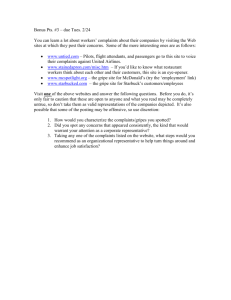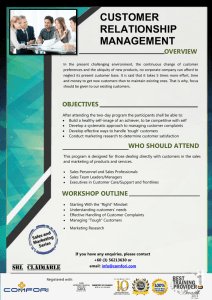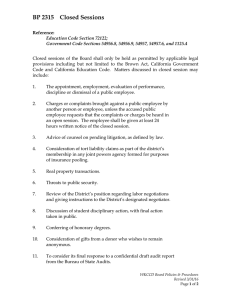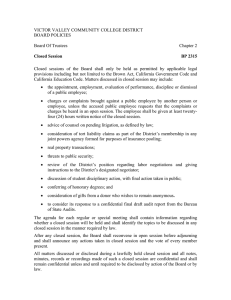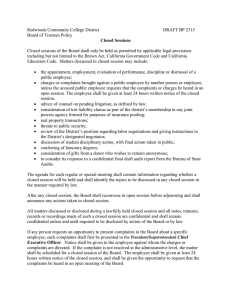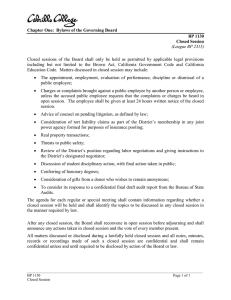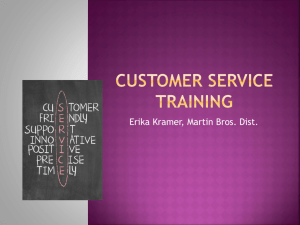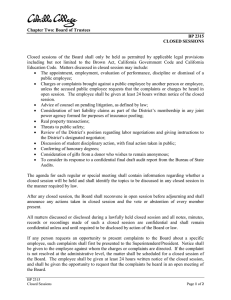Reading Guide
advertisement
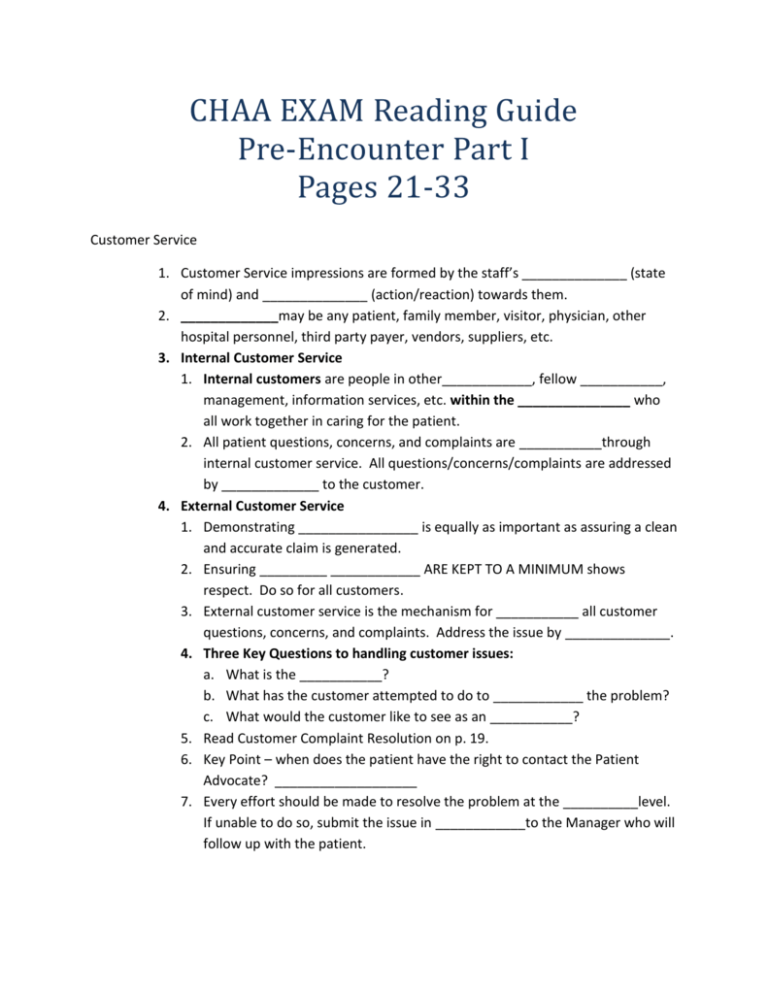
CHAA EXAM Reading Guide Pre-Encounter Part I Pages 21-33 Customer Service 1. Customer Service impressions are formed by the staff’s ______________ (state of mind) and ______________ (action/reaction) towards them. 2. _____________may be any patient, family member, visitor, physician, other hospital personnel, third party payer, vendors, suppliers, etc. 3. Internal Customer Service 1. Internal customers are people in other____________, fellow ___________, management, information services, etc. within the _______________ who all work together in caring for the patient. 2. All patient questions, concerns, and complaints are ___________through internal customer service. All questions/concerns/complaints are addressed by _____________ to the customer. 4. External Customer Service 1. Demonstrating ________________ is equally as important as assuring a clean and accurate claim is generated. 2. Ensuring _________ ____________ ARE KEPT TO A MINIMUM shows respect. Do so for all customers. 3. External customer service is the mechanism for ___________ all customer questions, concerns, and complaints. Address the issue by ______________. 4. Three Key Questions to handling customer issues: a. What is the ___________? b. What has the customer attempted to do to ____________ the problem? c. What would the customer like to see as an ___________? 5. Read Customer Complaint Resolution on p. 19. 6. Key Point – when does the patient have the right to contact the Patient Advocate? ___________________ 7. Every effort should be made to resolve the problem at the __________level. If unable to do so, submit the issue in ____________to the Manager who will follow up with the patient. 5. PATIENT RIGHTS AND RESPONSIBILITIES 1. Know your facilities policies and procedures addressing patient’s rights and responsibilities. 2. Patient safety is enhanced when patients are _____________ in the healthcare process as much as possible. 3. _______________ patients on their rights and responsibilities enhances this partnership. 4. Recognize each patient is an individual with unique healthcare needs, and be committed to assist them to EXERCISE THEIR RIGHT IN DETERMINING THEIR OWN CARE______________. 5. State and Federal laws require us to provide the rights and responsibilities to patients upon admission in a _______________ the can understand, in no smaller than ___ point font (unless otherwise required…this is typed in 12 pt font). Patient’s Rights will be ___________ in key locations throughout the facility as well. 6. Staff should ask patient if they would like the hospital to provide the patient’s next of kin/power of attorney agent with materials concerning their rights. 7. When patients have detailed questions about their rights, contact the hospital’s designee to assist the patient. If after hours, contact supervisor. E. STAFF BEHAVIORS 1. COMPASSION = _______________ 2. Show competence by: see common sense actions page 20. F. COMMUNICATION 1. Process by which messages are transmitted. Effective communication isn’t only talking; it also includes ENSURING YOUR MESSAGE HAS BEEN RECEIVED. 2. Communication Breakdown: 55% -Body Language; 38% -Tone of Voice; 7% -Words you use 3. Basis of Communication: 1.) There is a Message to be sent. (The message is _____________through words, gestures, tone of voice, etc). 2.) There is a person to send the message. (Message is _____________face to face, over the phone, through letter, etc). 3.) There is a person to receive the message. (Receiver _______________ the message based on what the symbols mean to them.) TEXTING!!!! 4. When communicating, you must OBTAIN _____________to clarify the message or validate the patient’s correct response. Avoid medical jargon. 5. Be aware of_______________. It’s the tone, volume, pitch, quality and range of speech and accounts for differences in communication based on age, language, cultures, education, and regional dialects and accents. 6. Observe and read _______________communication cues from patient and adjust approach accordingly. Are they scared, nervous, defensive, etc? 7. See list of ‘Barriers to Communication’ on p. 22. Make sure that your personal beliefs don’t get in the way. 8. EFFECTIVE LISTENING TECHNIQUES: Say, “Please tell me more about your concern.” Listen ______________by keeping your mind on what the speaker is saying. Stay motivated by ________________ THEY’RE SAYING SOMETHING IMPORTANT. Interact by nodding and making eye contact. Don’t begin to formulate your response until the patient has finished speaking. 9. Apply Heat: H –__________ them out; E – ______________ with the customer; A – ________________ for the inconvenience; T – _____________ responsibility for action. G. PATIENT COMMUNICATION TECHNIQUES 1. Ask _____________Ended Questions, questions that require more than a Yes/No response. They begin with Who, __________, Where, _______, and Why. 2. Have the patient ___________ by asking them to repeat what they heard. 3. ___________________ the patient’s response in your own words to ensure you heard them correctly 4. Allow _______________- they give us and the patient time to think and respond. H. ANGRY PATIENTS 1. Patients can become angry when they feel _________________and 2. 3. 4. 5. 6. experience a sense of loss of ____________. Anger could result from physical or emotional pain. It could also be related to the ____________ implications of their illness or condition. You must _____________ (calm down) volatile (unpredictable) situations with PATIENCE, TACT, AND DIPLOMACY. NEVER respond to a patient with anger by yelling or swearing at them. By talking calmly and slowly you demonstrate that you are _____________ and that helps diffuse the situation. Be honest if you can’t fix the problem, but assure them that the person who can is available and has been alerted. Don’t _______________ (downplay) their problem. Refer to office policies and procedures for dealing with aggressive and combative patients. I. TECHNICAL COMPETENCE 1. Registration staff should be able to: a. Ask right questions to complete ______________and verify __________. b. Answer patient’s questions relating to registration and ____________. c. Complete Registration with a high level of ________________. A. SENSITIVITY TO CUSTOMER NEEDS 1. Customer satisfaction is measured by the PATIENT’S ___________________ of the staff member’s effort to understand their _____________ situation. 2. Meeting patient’s PERSONAL REQUIREMENTS is important in achieving customer/patient satisfaction. 3. Remember that the patient is not ordinarily sick and is the one inconvenienced with their health issues. Be patient and don’t expect them to act as if they are __________________. 4. What does it mean to create a PATIENT CENTERED ENVIRONMENT? The goal is to create an EXPERIENCE the patient will RECOMMEND. 5. Continue to _______________ develop listening and empathetic communication through practice and training. B. RESPECT AND MAINTAIN PRIVACY 1. HIPPA is a federal act designed to protect patient _____________. It also encourages ____________________________ transactions and required new safeguards to protect the security and confidentiality of patient health information. 2. Provide the patient with your facilities Patient Privacy Practices. Speak to the patient _________________ (unless they request a family member be present) in an area where personal information cannot be _________________. The information must be given to them in a _________________ they understand. 3. Using technical terms and medical jargon leads to ______________ customer service and is referred to as ______________ _____________ to the patient. C. CUSTOMER ASSESSMENT – AGE SPECIFIC CRITERIA 1. Registration personnel are required to treat patients differently in relation to their______. They need to be competent on ______-___________ considerations including knowledge of _____________ growth and development and the patient’s ability to obtain and interpret information based on their age. 2. Tips on interacting with: A. School Children- They know their address and phone number. The main question in their life is, “_________?” They have a ___________ attention span, and are afraid of the unknown and getting hurt. Involve them in ____________________ and allow them to have some ____________ if possible. B. Adolescents – They are able to discuss problems and their ___________ are their most important influence. Their ________ _____________ often signals how they feel. Encourage them to ask ______________ because they may be afraid/embarrassed to ask. C. Adults – At peak of mental, verbal, reasoning, and information recall abilities. They have many other responsibilities (children, aging parents, etc) keep in mind. Consider their role, culture, and lifestyle when communicating with them. D. Seniors- Decreased _________________ and a slower ability to ____________ information. They have an increased concern for their health, retirement concerns, and death of spouse/ friends. Address as Mr./Mrs. ‘Last Name.’ Speak distinctly and repeat yourself if necessary.
